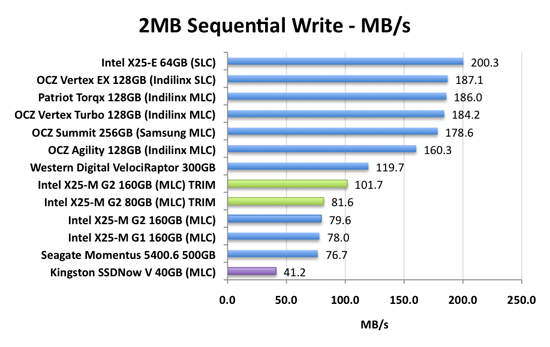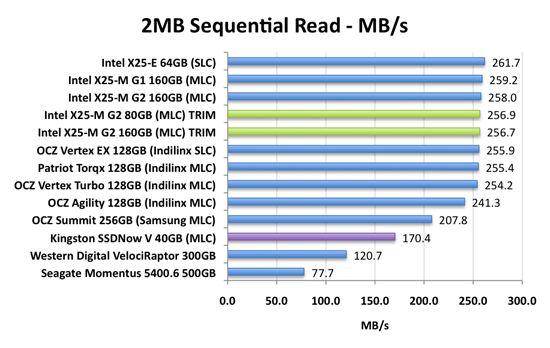The SSD Improv: Intel & Indilinx get TRIM, Kingston Brings Intel Down to $115
by Anand Lal Shimpi on November 17, 2009 7:00 PM EST- Posted in
- Storage
The Test
| CPU | Intel Core i7 965 running at 3.2GHz (Turbo & EIST Disabled) |
| Motherboard: | Intel DX58SO (Intel X58) |
| Chipset: | Intel X58 |
| Chipset Drivers: | Intel 9.1.1.1015 + Intel IMSM 8.9 |
| Memory: | Qimonda DDR3-1066 4 x 1GB (7-7-7-20) |
| Video Card: | eVGA GeForce GTX 285 |
| Video Drivers: | NVIDIA ForceWare 190.38 64-bit |
| Desktop Resolution: | 1920 x 1200 |
| OS: | Windows 7 x64 |
Sequential Read/Write Speed
Using the latest build of Iometer I ran a 3 minute long 2MB sequential write test over the entire span of the drive. The results reported are in average MB/s over the entire test length:

I ruined the surprise earlier, but the X25-M G2 160GB can now write at speeds of up to 100MB/s. The 80GB version doesn't get the benefit. The rest of the SSDs are approaching 2x that performance however. The poor Kingston drive is limited by its 5-channel implementation and barely manages more than 40MB/s. This will keep the Kingston SSDNow V series from cannibalizing X25-M sales, while at the same time offering a taste of what good SSDs have to offer at lower price points.

We're nearly tapped out on sequential read speed. The new TRIM firmware appears to drop performance a bit but not much. SATA 6Gbps will be necessary before we can see higher sequential read speeds from a single SSD.
True to Kingston's claims, the SSDNow V 40GB pulls around 170MB/s thanks to its narrower configuration. Not within arm's reach of the more expensive SSDs but still much faster than a mechanical drive.










162 Comments
View All Comments
mrt2 - Monday, November 23, 2009 - link
Ok so with all this new data in mind, what's currently the fastest, least performance degrading 256GB SSD you can get for under $1000? I'm currently running Snow Leopard on a dual quad core Mac Pro... I'm not sure Snow Leopard supports any of the new technologies like TRIM or not... but whatever the best 256GB SSD I can get, that's what I'd like....rdhir - Wednesday, November 18, 2009 - link
WARNING on Intel Matrix driversI just wanted to add a word of warning over drivers and SSD. I just built a new i5 750/P55 system with a Corsair X64 drive (Indilinx). While the system worked fine in bits it frequently froze. I tried lots of things to cure it, but in the end the fix was simple. I HAD to use the Intel drivers to avoid intermittent freezing.
Because I had made the SSD the C:drive and used a 1TB Samsung F2 as the D: drive, I had not wanted to lose TRIM support, until the new AHCI drivers came out, but MS drivers don't work. reference article is here http://derek858.blogspot.com/2009/01/windows-7-int...">http://derek858.blogspot.com/2009/01/windows-7-int...
Reading around some of the othere references Its inconsistent and depends on how the drives implements the command set so your mileage may vary but I think its a big issue.
I think we could all do with an article on how best to configure an SSD based system. I decided that I wanted to move "Users" and all associated hidden directories to the D: drive (a 1TB HD) leaving the 64GB for Windows and Apps. This would mean it would never get too full.
I'm amazed at how difficult Microsoft make it to shift the "Users" directory to another drive. In fact they have a Knowledge base article saying not to - Linux easy, just map /home elsewhere.
In the end I followed some instructions to create a junction from C:\Users to D:\Users, but its non-trivial and involves opening a command window in the middle of the installation process.
Yes I'd like to have done it with an autounattend.txt but the MS KB articles says it won't really work.
mapesdhs - Thursday, November 19, 2009 - link
> In the end I followed some instructions to create a junction from
> C:\Users to D:\Users, but its non-trivial and involves opening a
> command window in the middle of the installation process.
I can't see this sort of thing becoming any easier until MS ditches
the archaic idea of drive letters and switches to a more natural
unified file system such as is used with all UNIX OS variants.
(oh look, the pits of hell seem to be getting a tad icey...)
Ian.
MadAd - Thursday, November 19, 2009 - link
"I think we could all do with an article on how best to configure an SSD based system"That would be great
CuriousMike - Monday, November 23, 2009 - link
" "I think we could all do with an article on how best to configure an SSD based system""That would be great " "
Thirded.
The variety of do's and don'ts (and conflictions) are numerous:
-do disable pagefile. don't. oh, which OS?
-don't defrag disk. do. oh, which OS?
-use ram disk for temp files. don't. no, wait, do.
ol1bit - Wednesday, November 18, 2009 - link
I can't believe they don't have firmware for my drive to trim it... I just bought the sucker 3 months ago.....Intel X25-M SSDSA2MH080G1 80GB SATA II MLC Internal Solid state disk (SSD)
dagamer34 - Wednesday, November 18, 2009 - link
No TRIM for G1 drives. Sorry.yacoub - Tuesday, November 17, 2009 - link
An old article reposted as new simply because of a couple-sentence-long update? Interesting.Also, $85? No, try $130 and no MIR. Thanks ScrewEgg!
http://www.newegg.com/Product/Product.aspx?Item=N8...">http://www.newegg.com/Product/Product.a...pk=kings...
7Enigma - Tuesday, November 17, 2009 - link
If the only update was the 2 short blurbs at the top of the first page I don't think this entire article should be reposted. A simple statement with a link to the previous article would be fine. I just wasted a couple minutes going through each page realizing nothing was new....not cool. I was psyched for another SSD article Anand!max22 - Tuesday, November 17, 2009 - link
I installed Intel's pulled firmware fine on my G2 drives. Nothing happen to them at all. I think the whole issue has been blown way over the top.